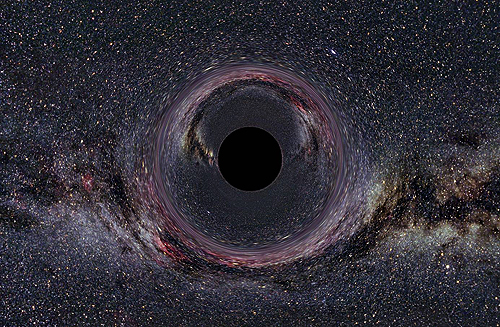Scientists Observe a Black Hole Eating a Star
An international team of astrophysicists led by a Johns Hopkins University scientist has for the first time witnessed a black hole eating a star and ejecting a flare of matter moving at nearly the speed of light. The reason for such observation to be one of the scientific breakthroughs is because this beautiful act led to unfold new secrets of the galaxy, pitching towards revealing the characteristics of the dark matters.
The super-massive black hole was found to have faint jets of material shooting out from it and helps to confirm scientists’ theories about the nature of black holes.
The discovery was published in the journal Science, the report describe the star “about the size of our sun, as it shifts away from its customary path slipping in to the gravitational pull of the super-massive black hole and sucked in” said Sojoert van Velzen, a hubble fellow at John Hopkins.
He added “These events are extremely rare, in fact it’s the first time we see everything from stellar destruction followed by the launch of a conical outflow, also called a jet, and we watched t unfold over several months.”
What really happens?
Black holes are the areas in space, dense and with irresistible gravitational force through which no matter, gas or even light can pass making them those invisible voids in the fabric of the space. Astrophysicists had predicted that when large amount of gas is force-fed to the black hole (in this case the star) then a fast moving jet of plasma ( Elementary particles in a magnetic field) escapes from near the black hole rim “the event horizon”. This study proves the prediction to be correct.

“Previous efforts to find evidence for these jets, including my own, were late to the game,” said Van Velzen who led the analysis with coordinated efforts from 13 other scientists in the United States, the Netherlands, Great Britain and Australia,
Supermassive black holes are believed to prevail at the center of most of the massive galaxies. The discovery is the first time scientists have been able to see both a disk of material falling into a black hole( known as an accretion disk), and a jet in a system of this kind.
ICRAR astrophysicist Dr James Miller-Jones compared the energy produced by the jets in this event to the entire energy output of the Sun over 10 million years. He said it was likely all super-massive black holes swallowing stars launched jets but this discovery was made because the black hole is relatively close to Earth and was studied soon after it was first seen. This galaxy is about 300 million light years(One light year is 5.88 trillion miles.) away, while the others were at least three times farther away. This particular black hole lies at the lighter end of the super-massive black hole spectrum, at only about a million times the mass of our sun, but still packing the force to gobble a star.
The first observation of the star being destroyed by a black hole was made by a team at the Ohio State University, using an optical telescope in Hawaii. That team announced its discovery on Twitter in early December 2014. After reading about the event, van Velzen contacted an astrophysics team led by Rob Fender at the University of Oxford in Great Britain, The group used radio telescopes to follow up as fast as possible. They were just in time to catch the action.By the time it was done; the international team had data from satellites and ground-based telescopes that gathered X-ray, radio and optical signals, providing a stunning “multi-wavelength” portrait of this event.

The first step for the team was to rule out the possibility that the light received was from a pre-existing expansive swirling mass called an “accretion disk” that is formed when the black hole is sucking in the matter from space. That helped to confirm that the sudden increase of light from the galaxy was due to a newly trapped star.
“The destruction of a star by a black hole is beautifully complicated, and far from understood,” van Velzen said. “From our observations, we learn the streams of stellar debris can organize and make a jet rather quickly, which is valuable input for constructing a complete theory of these events.” Van Velzen last year completed his doctoral dissertation at Radboud University in the Netherlands, where he studied jets from supermassive black holes. In the last line of the dissertation, he expressed his hope to discover these events within four years. It turned out to take only a few months after the ceremony for his dissertation defense.
Although Velzen’s team were not the only ones who worked on this observation a group from Harvard observed the same source with the radio telescopes in New Mexico and announced results online Both teams presented results at a workshop in Jerusalem in early November. It was the first time the two competing teams had met face to face. “The meeting was an intense, yet very productive exchange of ideas about this source,” van Velzen said. “We still get along very well; I actually went for a long hike near the Dead Sea with the leader of the competing group.”
Black holes had always been mystic bodies floating in space gulping stars and other matters in the space, scientists have gone through numerous galaxies in search of information on these dark matters, the observations from this particular unlucky star revealed many secrets of the massive bodies, but the space still remains with a huge pile of unheard secrets yet to be unfolded.
The video shows a similar black hole in action.





